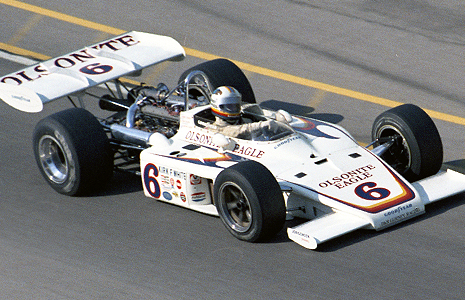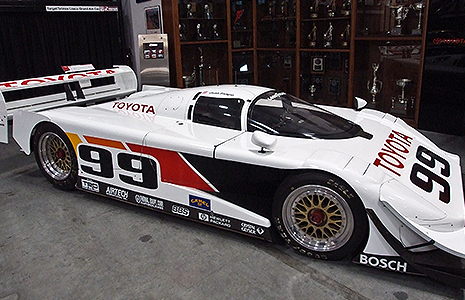INDYCAR Voices: Getting the lowdown on downforce
JUN 22, 2016
(This is the first of a three-part series from Verizon IndyCar Series driver JR Hildebrand.)
The debate around Indy car downforce levels has wicked up over the last two years, so let’s talk about it.
 It’s an interesting but complicated conversation – there are a lot of factors in play. Generally speaking, aerodynamics has been a significant part of the performance of Indy cars since the ‘70s. In 1972, the track record at Indy increased from 178.7 mph to 195.9 mph in one year with the allowance of bolt-on wings (Bobby Unser's Olsonite Eagle that won the '72 pole is shown at left), and the cars have gone faster at all types of tracks ever since because of aerodynamic development. But where has that led, and to what end?
It’s an interesting but complicated conversation – there are a lot of factors in play. Generally speaking, aerodynamics has been a significant part of the performance of Indy cars since the ‘70s. In 1972, the track record at Indy increased from 178.7 mph to 195.9 mph in one year with the allowance of bolt-on wings (Bobby Unser's Olsonite Eagle that won the '72 pole is shown at left), and the cars have gone faster at all types of tracks ever since because of aerodynamic development. But where has that led, and to what end?
I’ve done a little homework and hope to shed some light on where things currently stand (hopefully with enough detail to really understand it), how that roughly compares to other current and historical cars, and what some projections could look like going forward. I worked with the Ed Carpenter Racing engineers to simulate a variety of scenarios, so these are definitely data-driven.
We’re going to break this into three parts: Part 1 will focus on the road/street course downforce as an introduction, Part 2 will focus on short ovals, with Part 3 focusing on superspeedways and, most notably, Indianapolis.
Before we dig into this, you need to understand how we define downforce levels/configurations for the sake of comparison. Downforce is generated at a squared rate relative to speed, so if a car doubles in speed, the amount of downforce it generates will quadruple (a car that generates 1,000 pounds of downforce at 100 mph will generate 4,000 pounds of downforce at 200 mph). The faster you go, the more downforce (and drag) you make, at an increasing rate. Since it’s not linear, this can make comparing downforce levels at different speeds rather confusing. Because of this, we discuss aerodynamic configurations in terms of downforce at 200 mph. This nominal standard allows us to compare aero configurations apples to apples, regardless of on-track circumstances.
Part 1: Road and street courses
The current Indy car is capable of generating A TON of downforce. Actually, multiple tons. That’s partly the result of the Dallara IR-12 being a high-downforce machine to start with, but Chevrolet and Honda have taken it to a whole new level via the aero kits, now in their second year.
Honda and Chevy continue to develop their engines, but the ability to increase performance through aerodynamics has been a much larger opportunity. Historically, speed is kept in check by sanctioning bodies like INDYCAR controlling engine output, so aerodynamics has become the primary source of performance improvement.
In maximum downforce trim, a current Indy car generates between 6,500 and 7,000 pounds of downforce at 200 mph. That is not only the most an Indy car has ever made, but more than a current F1 car generates, by most accounts. The Indy car generates its own weight (around 1,600 pounds) in downforce at less than 100 mph.
As ridiculous as it sounds, that doesn’t even begin to tell the story of what Chevy and Honda have been able to do because INDYCAR has made preemptive adjustments since the introduction of the aero kits to counteract their efforts and reduce downforce. To put their work in even greater perspective, if INDYCAR had not mandated removal of the diffuser strakes and sidewalls, in addition to requiring large sections of the floor to be removed when the aero kits were first introduced, the cars could potentially be making downforce in the neighborhood of 8,500-9,000 pounds.
 That would likely be more than an F1 car has ever made and would be giving the highest downforce cars in history – the 1993 IMSA GTP cars (shown at left), though they weighed hundreds of pounds more – a run for their money. Just with the stock floor. With the Indy car’s lack of power steering, you could reasonably argue that the cars would generate so much load they’d be undriveable.
That would likely be more than an F1 car has ever made and would be giving the highest downforce cars in history – the 1993 IMSA GTP cars (shown at left), though they weighed hundreds of pounds more – a run for their money. Just with the stock floor. With the Indy car’s lack of power steering, you could reasonably argue that the cars would generate so much load they’d be undriveable.
So the work the two manufacturers have actually done to improve the performance of the car within the regulations is pretty insane. They have achieved a substantially higher level of downforce than the original IR-12 while the most efficient aerodynamic device on the car (the underbody) was essentially taken away.
Along with that increase in downforce over the last two years, INDYCAR has seen track records fall that have stood for 10-15 years. A new track record has been set at every road- or street-course event this year with the exception of Long Beach, which was reset last year. Cornering speed and braking ability have long been the differentiating factor when comparing open-wheel performance to other types of cars, but the added downforce generated by the more optimized aero kits has increased these capabilities to a level almost beyond comprehension. The cars now exceed four Gs regularly, with peak Gs more than five. Say what you will about the cars looking difficult to drive, the commitment required just to drive the car at its limit is serious.
Verizon IndyCar Series teams will run the cars in max or close-to-max downforce configuration at most road and street courses. The manufacturers have developed the cars to make as much downforce as possible while being cognizant of drag efficiency, and the teams use as much of it as they can for each given situation. Why? Because given the regulations, that is unequivocally the fastest way to get around every racetrack.
So what do we think of all that, and what does it mean?
There’s a lot to consider. An interesting starting point is to think about the questions: Why do the cars make so much downforce and how did we arrive at this point? It’s a very difficult set of questions to answer, quite frankly. I’d say they make as much downforce as they do because the rules allow it. The rules allow it because it presents a domain for competition between manufacturers while also increasing the total performance (lap time) of the cars and series without substantially changing the formula.
More generally, I think it’s the natural direction that open-wheel cars traditionally go when improvements (safety or otherwise) allow for performance increase, and that we’ve arrived at this point as a product of that incremental process over the last couple decades.
I also don’t think that any of what I just wrote is a very good answer to the question of why the cars make so much downforce.
A common train of thought is that the cars make too much downforce. That tends to come with the opinion that the cars are not difficult enough to drive, they don’t look difficult enough to drive and/or the racing would be better if they were not so reliant on aerodynamics. There is probably a varying degree of truth in each of these opinions, but the cars having more or less downforce is only part of the puzzle that would address these concerns. To start with, this comes down to the ratio and relationship of downforce, drag and power.
Take Sonoma Raceway, for example. Let’s say we decrease downforce by almost 40 percent from 6,500 to 4,000 pounds, which also reduces drag by a similar amount. That’s a big swing because Indy cars have been capable of making 4,000 pounds of downforce since the ‘80s and a NASCAR Cup car can make between 3,500-4,000 pounds of downforce at this same track (seriously).
What does this decrease do? When simulated, the car is 5-10 mph slower in every corner (the faster the corner, the more it slows), the braking distances grow in somewhat significant fashion (+75-100 feet), it’s faster down the straightaways by 6-8 mph, but is slower on the overall lap by more than 2 seconds. So by reducing downforce and drag, we have a car that doesn’t do the things it does well nearly as well, but goes a bit quicker on the straights for a net performance loss. What would it take to get back to the same lap time with an increase of power?
To make back this 2 seconds purely with horsepower, the engine will have to produce somewhere in the neighborhood of 950 horsepower.
Which, really, doesn’t sound all that awful, if you ask me.
So this is where our conversation really begins. In the next installment, we’ll look at the short oval downforce, drag and power combination (spoiler alert: it’s way more extreme), and start to uncover some of the other factors that are in play as we continue to think about the “whys” of the formula.
There’s no doubt that Indy cars are bad fast in their current spec … but could they be more badass? We’ll see.























